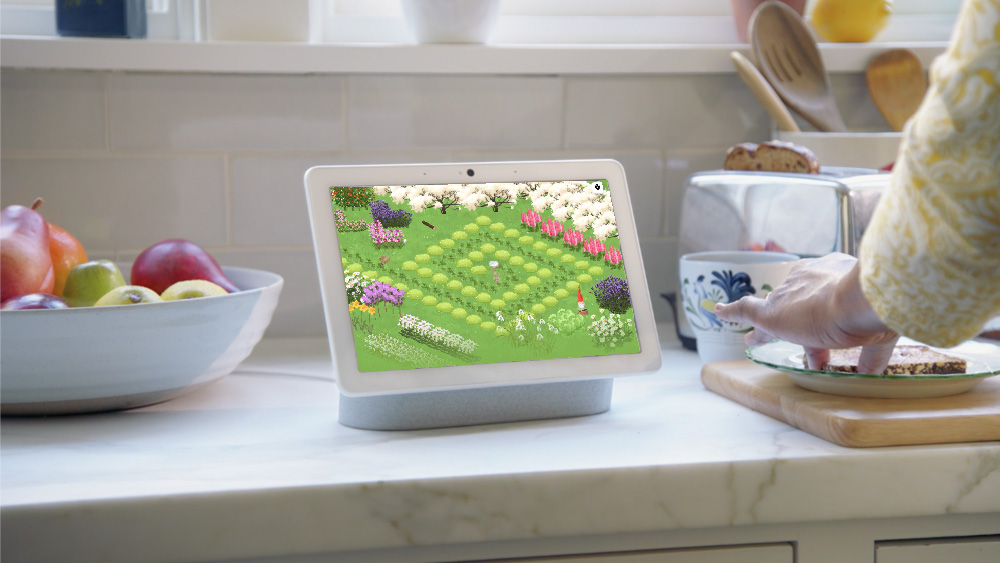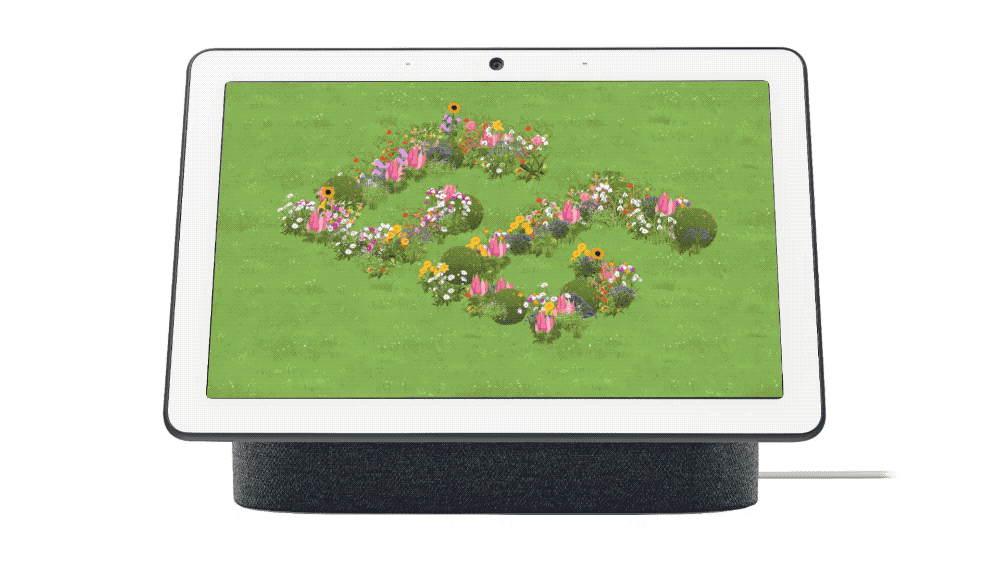智慧螢幕是成長最快速的住宅裝置之一,是一種新遊戲平台。有螢幕的 Google 助理裝置提供豐富的視覺內容和遊戲,可讓玩家享受娛樂。
瞭解為何要建構智慧螢幕、如何建構智慧螢幕,以及如何在更多裝置上擴充遊戲。
設計智慧螢幕
智慧螢幕創造了新的遊戲空間:在廚房流理台、沙發旁或起居室上。這些裝置位於這些高流量的多人區域,幾乎任何地點都能讓家中任何人使用。只要輸入幾個字詞,就能讓多人快速存取您的遊戲。

智慧螢幕裝置的遊戲空間與其他遊戲平台不同。多人可能在同一間會議室參與,非遊戲活動可能會同時進行。這個環境提供建構遊戲的一些獨特挑戰和機會:
- 遠距互動:玩家可能四處移動,透過幾個步驟與裝置交談,與其互動時看不看螢幕。因此,您的遊戲必須可透過語音互動完整玩,並避免玩家必須輕觸螢幕。此外,您還要設計出在遠處時,玩家都能輕鬆閱讀的遊戲視覺效果。
- 多個同時參與的玩家輸入:智慧螢幕適用於涉及多人的遊戲,因此請考慮一次與多位玩家互動。因此,請確保讓不同裝置的人都能輕鬆存取遊戲圖像。
- 共用公共空間:智慧螢幕通常位於流量較高的地方,例如客廳和廚房。請考量您的遊戲在遊戲過程中可能會如何結合或結合其他進行的活動,例如烹飪、打掃、作業或友誼辯論。
如要深入瞭解如何建立有效語音介面的深入原則,請參閱對話設計網站。您也可以參考 Android 的設計電視專用原則,此概念分享了類似的實用建議,以設計出遠距離的玩家互動。
在技術方面,Google 助理開發人員平台提供互動式畫布架構,可讓您使用熟悉的網頁開發工具為智慧螢幕建構遊戲。這個架構可讓您打造全螢幕視覺和對話體驗。想進一步瞭解如何透過互動式畫布進行建構,請參閱開發人員說明文件。
透過語音打造視覺遊戲
從早期的遊戲主機到現代手機遊戲,玩家都期待遊戲提供優質的視覺體驗。智慧螢幕提供一種全新的方式,也就是為玩家提供這類體驗,與玩家互動。
 智慧螢幕具備令人熟悉的大型觸控螢幕,再加上語音介面的速度,能夠從現有遊戲到支援語音功能的遊戲體驗之間創造橋樑。玩家只要說「Ok Google,我要玩遊戲」,即可快速進入遊戲。如果進入陌生地區,畫面會提供一個舒適的輸入選項。
智慧螢幕具備令人熟悉的大型觸控螢幕,再加上語音介面的速度,能夠從現有遊戲到支援語音功能的遊戲體驗之間創造橋樑。玩家只要說「Ok Google,我要玩遊戲」,即可快速進入遊戲。如果進入陌生地區,畫面會提供一個舒適的輸入選項。
針對 Google 助理生態系統中同時具備顯示功能和語音介面的裝置,可為使用者提供兩種互動、娛樂和協助的方式,為遊戲創造最佳執行機會。
將觸及範圍延伸至更多裝置
Google 助理不只在智慧螢幕上運作,雖然您應該先設計智慧螢幕,但請記下其他可以玩遊戲的 Google 助理裝置。值得注意的是,智慧型手機佔裝置人口的大部分比例,且智慧音箱使用率持續增加。
配合智慧型手機進行調整
如何針對智慧型手機最佳化 Google 助理遊戲:
- 使用回應式設計:運用回應式網頁設計技巧,根據不同螢幕大小進行調整,尤其是在手機螢幕較小時。Google 助理使用 HTML 技術處理視覺內容,因此您可以使用許多已知的回應式設計遊戲。
- 考量音量:由於智慧型手機會隨時隨地使用,因此玩家通常會調低音量。建議您提醒玩家在遊戲開始時檢查音量,但因為身處位置很小,或通勤很吵雜,可能無法使用音效。請務必在設計中呈現這項功能,除了使用語音之外,還能讓使用者透過觸控瀏覽遊戲,並確保音訊提示中的重要資訊也能清晰判讀。
針對智慧音箱進行調整
隨著玩家群對遊戲的熟悉度日益熟悉,您或許會想使用純語音介面,讓新玩家更容易理解您的遊戲。
考量遊戲如何在純音訊模式下運作,請將遊戲過程縮減至受限模式或切換至資訊模式。舉例來說,如果玩家透過純語音裝置啟動遊戲,您可以針對遊戲功能、新聞、任務更新或排行榜狀態提供更新。
如要進一步瞭解如何為講者設計純語音互動,請參閱對話設計網站。

